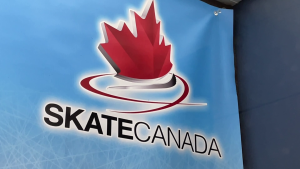Skate Canada removes gender barrier in pairs skating
Posted December 14, 2022 8:36 pm.
Last Updated December 14, 2022 8:46 pm.
Skate Canada has removed a gender restrictive barrier in ice skating.
A pair of ice skaters can now be any two people who skate together, instead of between one man and one woman.
On Monday, the group announced that the updated definition of ‘team’ is set to be changed from “one woman and one man,” to “two skaters.”
The group adds that the change is apart of their Skating for Everyone initiative and is in line with Skate Canada’s commitment to “non-discrimination based on gender identity.”

Skate Canada has removed a gender restrictive term in ice skating. (Monika Gul/CityNews)
“By updating the definition of team, many individuals in the figure skating community in Canada will have new opportunities to embrace the sport,” Karen Butcher, President of Skate Canada, said in a news release.
Celebrating the change
For Canadian ice dance champion and two-time Olympian, Kaitlyn Weaver, she says she is celebrating the change.
As part of the Skate Canada Equity Diversity, Inclusion and Accessibility Operating Committee, Weaver says the committee has been pushing for the change.
“We want to reflect the morals and beliefs of our country,” she said.
“Every person is valid, every story is valid, and everyone belongs on the ice, no matter how you identify.”
Weaver says she is also a passionate advocate for the 2SLGBTQ+ community, and wants to make sure everyone has a place on the ice.

Skate Canada has removed a gender restrictive term in ice skating. (Monika Gul/CityNews)
“I didn’t even think it was an option to be gay in my sport,” she explained. “I also feel like this is somewhat of a personal victory as well on behalf of the queer community, and everyone else that just wants to skate with whoever they want.”
Ted Barton, the executive director of Skate Canada B.C. and Yukon, says that the change will also open up an opportunity for creative changes.
“I like the concept from a whole number of areas, obviously for equity, diversity, and inclusion, that’s the number one thing, but also from a creative perspective. I think it’ll be really wonderful,” Barton explained.
Michael Robach with Qmunity, a non-profit in Vancouver that works at improving queer, trans, and two-spirit lives, says the change opens the door to more opportunities for people to feel seen.

On Monday, Skate Canada announced that the updated definition of ‘team’ is set to be changed from “one woman and one man,” to “two skaters.” (Monika Gul/CityNews)
“I think this sets a really good precedent, and I think it really leads the way to more changes in particular in sports for all identities to feel recognized and for them to have space,” Robach explained.
He adds that although the change will be on the ice, the impact has the potential to reach much farther.
“I think in sports, oftentimes, it’s not just about the athletes on the field or on the ice, it’s about the people at home who are watching, and those include adults, and sometimes kids, who have all sorts of different identifies…I think representation on the screen enables them to consider the possibility that there is space for them, that they are celebrated,” Robach said.
Weaver says although the sport traditionally featured a male and female couple, the change brings out an opportunity for new stories to be told.
“Figure skating is such a beautiful sport that’s entrenched in tradition. When we watch a pairs or dance couple, we see a man and a woman tell a story,” Weaver said.
Related Articles:
-
Lace up your skates! Some notable Metro Vancouver rinks are opening
-
Canadian Women’s Foundation launches course on how to respond to distress gesture
-
B.C. adding consent education resources to school curriculum
“But there’s so many stories that we can tell.”
Barton says that he believes Canada is the first to implement the change, and although the rules only apply to domestic events by Skate Canada, the group is hopeful that international groups will follow suit.
“I think the International Skating Unit is looking very closely at what we’re doing and considering as well. It’s more complicated, because theirs is a world body, it’s way more complicated than one particular country. But there’s no question that there’s the initative to move in this direction,” he explained.
Weaver adds that she hopes that the group can be an example to others.
“We absolutely feel that Canada can lead the way and be an example of what skating can be,” she said.










